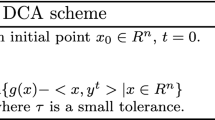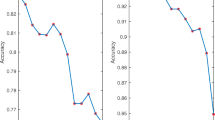Abstract
Breast cancer is the second leading cause of cancer related death for women in the world, and mass is one of the most common kinds of abnormal. A mass can be either benign or malignant, the accurate diagnosis is important for early intervention and treatment. In this paper, we investigated the mass classification problem and proposed a new method for feature selection. The proposed method integrates joint \({l_{2,1}}\)-norm minimizing regularization with a nonparallel twin support vector machine, which is called TWSVML21. The \({l_{2,1}}\)-norm regularization selects features across positive and negative classes with joint sparsity, and features are selected by a ranking strategy. An iterative method is proposed to solve the involved optimization problem. Preliminary results on mass classification and several benchmark datasets showed the feasibility and effectiveness of the proposed TWSVML21 method.






Similar content being viewed by others
References
Ferlay J et al (2015) “Cancer incidence and mortality worldwide: sources, methods and major patterns in GLOBOCAN 2012”. Int J Cancer 136(5):E359–E386
Samulski M, Karssemeijer N (2011) Optimizing case-based detection performance in a multiview CAD system for mammography. IEEE Trans Med Imaging 30(4):1001–1009
Liu X, Mei M, Liu J, Hu W (2015) “Microcalcification detection in full-field digital mammograms with PFCM clustering and weighted SVM-based method”. EURASIP J Adv Signal Process 2015(1):1
Tang J, Rangayyan RM, Xu J, El Naqa I, Yang Y (2009) Computer-aided detection and diagnosis of breast cancer with mammography: recent advances. IEEE Trans Inf Technol Biomed 13(2):236–251
Eltonsy NH, Tourassi GD, Elmaghraby AS (2007) A concentric morphology model for the detection of masses in mammography. IEEE Trans Med Imaging 26(6):880–889
Pereira DC, Ramos RP, Do Nascimento MZ (2014) Segmentation and detection of breast cancer in mammograms combining wavelet analysis and genetic algorithm. Comput Methods Prog Biomed 114(1):88–101
Chan H-P et al (1995) Computer-aided classification of mammographic masses and normal tissue: linear discriminant analysis in texture feature space. Phys Med Biol 40(5):857–876
Eltoukhy MM, Faye I, Samir BB (2012) A statistical based feature extraction method for breast cancer diagnosis in digital mammogram using multiresolution representation. Comput Biol Med 42(1):123–128
Cheng H, Shi X, Min R, Hu L, Cai X, Du H (2006) Approaches for automated detection and classification of masses in mammograms. Patt Recognit 39(4):646–668
Ganesan K, Acharya UR, Chua CK, Min LC, Abraham KT, Ng K-H (2013) Computer-aided breast cancer detection using mammograms: a review. IEEE Rev Biomed Eng 6:77–98
Liu X, Tang J (2014) Mass classification in mammograms using selected geometry and texture features, and a new SVM-based feature selection method. IEEE Syst J 8(3):910–920
Shmilovici A (2005) Support vector machines. In: Data mining and knowledge discovery handbook. Springer, pp 257–276
Suykens JA, Vandewalle J (1999) Least squares support vector machine classifiers. Neural Process Lett 9(3):293–300
Sun B, Ng WW, Chan PP (2016) Improved sparse LSSVMS based on the localized generalization error model. Int J Mach Learn Cybern 1–9
Pan X, Xu Y (2016) Two effective sample selection methods for support vector machine. J Intell Fuzzy Syst 30(2):659–670
He Q, Wang X, Chen J, Yan L (2006) A parallel genetic algorithm for solving the inverse problem of support vector machines. Adv Mach Learn Cybern 871–879
Wang X-Z, Lu S-X, Zhai J-H (2008) Fast fuzzy multicategory SVM based on support vector domain description. Int J Pattern Recognit Artif Intell 22(01):109–120
Wang X-Z, RAR Ashfaq, Fu A-M (2015) “Fuzziness based sample categorization for classifier performance improvement. J Intell Fuzzy Syst 29(3):1185–1196
Hu L, Lu S, Wang X (2013) A new and informative active learning approach for support vector machine. Inf Sci 244:142–160
Qi Y, Zhang G (2016) Strategy of active learning support vector machine for image retrieval. IET Comput Vis 10(1):87–94
Dufrenois F, Noyer JC (2015) Generalized eigenvalue proximal support vector machines for outlier description. In: 2015 International Joint Conference on Neural Networks (IJCNN), 2015, pp 1–9: IEEE
Khemchandani R, Chandra S (2009) Optimal kernel selection in twin support vector machines. Optim Lett 3(1):77–88
Kumar MA, Gopal M (2009) Least squares twin support vector machines for pattern classification. Expert Syst Appl 36(4):7535–7543
Tian Y, Ju X, Qi Z, Shi Y (2014) Improved twin support vector machine. Sci China Math 57(2):417–432
Shao Y-H, Zhang C-H, Wang X-B, Deng N-Y (2011) Improvements on twin support vector machines. IEEE Trans Neural Netw 22(6):962–968
Xu Y, Chen M, Yang Z, Li G (2016) ν-twin support vector machine with Universum data for classification. Appl Intell 44(4):956–968
Xu Y, Yu J, Zhang Y (2014) KNN-based weighted rough ν-twin support vector machine. Knowl-Based Syst 71:303–313
Xu Y, Yang Z, Pan X (2017) A novel twin support-vector machine with pinball loss. IEEE Trans Neural Netw Learn Syst 28(2):359–370
Tomar D, Agarwal S (2015) Twin support vector machine: a review from 2007 to 2014. Egypt Inf J 16(1):55–69
Yang Z-M, He J-Y, Shao Y-H (2013) Feature selection based on linear twin support vector machines. Proc Comput Sci 17:1039–1046
Guo J, Yi P, Wang R, Ye Q, Zhao C (2014) Feature selection for least squares projection twin support vector machine. Neurocomputing 144:174–183
Bai L, Wang Z, Shao Y-H, Deng N-Y (2014) A novel feature selection method for twin support vector machine. Knowl-Based Syst 59:1–8
Fan R-E, Chang K-W, Hsieh C-J, Wang X-R, Lin C-J (2008) LIBLINEAR: a library for large linear classification. J Mach Learn Res 9:1871–1874
Nie F, Huang H, Cai X, Ding CH (2010) Efficient and robust feature selection via joint l 2,1-norms minimization. Adv Neural Inf Process Syst 1813–1821
Tian Y-J, Ju X-C (2015) Nonparallel support vector machine based on one optimization problem for pattern recognition. J Oper Res Soc China 3(4):499–519
Platt JC (1999) 12 fast training of support vector machines using sequential minimal optimization. In: Advances in kernel methods, pp 185–208
Andersen ED, Andersen KD (2000) The MOSEK interior point optimizer for linear programming: an implementation of the homogeneous algorithm. In: High performance optimization. Springer, pp 197–232
Duda RO, Hart PE, Stork DG (2001) Pattern classification, 2nd edn. New York
Robnik-Šikonja M, Kononenko I (2003) Theoretical and empirical analysis of ReliefF and RReliefF. Mach Learn 53(1–2):23–69
Huang J, Zhang T (2010) The benefit of group sparsity. Ann Stat 38(4):1978–2004
Moreira IC, Amaral I, Domingues I, Cardoso A, Cardoso MJ, Cardoso JS (2012) INbreast: toward a full-field digital mammographic database. Acad Radiol 19(2):236–248
Moura DC et al (2013) Benchmarking datasets for breast cancer computer-aided diagnosis (CADx). In: Iberoamerican Congress on Pattern Recognition, 2013. Springer, pp 326–333
Dhungel N, Carneiro G, Bradley AP (2016) The automated learning of deep features for breast mass classification from mammograms. In: International Conference on Medical Image Computing and Computer-Assisted Intervention, 2016, pp 106–114. Springer
Liu X, Zeng Z (2015) A new automatic mass detection method for breast cancer with false positive reduction. Neurocomputing 152:388–402
Haralick RM, Shanmugam K, Dinstein IH (1973) Textural features for image classification. IEEE Trans Syst Man Cybern (6):610–621
Jähne B (2002) Digital image processing. IOP Publishing
Mudigonda NR, Rangayyan RM, Desautels JL (2000) Gradient and texture analysis for the classification of mammographic masses. IEEE Trans Med Imaging 19(10):1032–1043
Li H, Kallergi M, Clarke L, Jain V, Clark R (1995) Markov random field for tumor detection in digital mammography. IEEE Trans Med Imaging 14(3):565–576
Chang C-C, Lin C-J (2011) LIBSVM: a library for support vector machines. ACM Trans Intell Syst Technol (TIST) 2(3):27
Peng H, Long F, Ding C (2005) Feature selection based on mutual information criteria of max-dependency, max-relevance, and min-redundancy. IEEE Trans Pattern Anal Mach Intell 27(8):1226–1238
Yang Y, Ma Z, Hauptmann AG, Sebe N (2013) Feature selection for multimedia analysis by sharing information among multiple tasks. IEEE Trans Multimed 15(3):661–669
Metz C (2006) ROCKIT 1.1 B2 (beta version for Windows operating system) [Computer software]. University of Chicago, Chicago, UK. http://www-radiology.uchicago.edu/krl/KRL_ROC/software_index6.htm
Gu Q, Li Z, Han J (2012) Generalized fisher score for feature selection. arXiv preprint: arXiv:1202.3725
Cai X, Nie F, Huang H, Ding C (2011) Multi-class l 2,1-norm support vector machine. In: 2011 IEEE 11th International Conference on Data Mining, 2011, pp 91–100: IEEE
Guyon I, Weston J, Barnhill S, Vapnik V (2002) Gene selection for cancer classification using support vector machines. Mach Learn 46(1–3):389–422
Hanley JA, McNeil BJ (1983) A method of comparing the areas under receiver operating characteristic curves derived from the same cases. Radiology 148(3):839–843
Cevikalp H (2016) Best fitting hyperplanes for classification. IEEE Trans Pattern Anal Mach Intell
Peng X (2011) TPMSVM: a novel twin parametric-margin support vector machine for pattern recognition. Pattern Recognit 44(10–11):2678–2692
Platt JC (1999) Fast training of support vector machines using sequential minimal optimization. In: Advances in kernel methods, pp 185–208
Acknowledgements
This work is partially supported by the National Natural Science Foundation of China (Nos. 61403287, 61472293, 31201121, 61572381, 61273303), China Postdoctoral Science Foundation (No. 2014M552039) and the Natural Science Foundation of Hubei Province (No. 2014CFB288).
Author information
Authors and Affiliations
Corresponding author
Rights and permissions
About this article
Cite this article
Liu, X., Zhu, T., Zhai, L. et al. Mass classification of benign and malignant with a new twin support vector machine joint \({l_{2,1}}\)-norm. Int. J. Mach. Learn. & Cyber. 10, 155–171 (2019). https://doi.org/10.1007/s13042-017-0706-4
Received:
Accepted:
Published:
Issue Date:
DOI: https://doi.org/10.1007/s13042-017-0706-4




